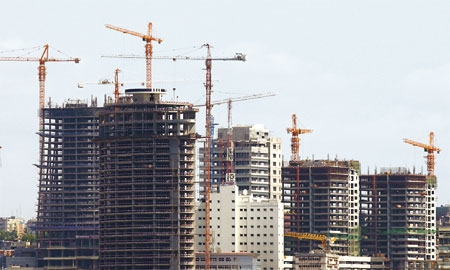
Angola is slowly but surely repairing or replacing buildings and infrastructure that were degraded during the 27-year civil conflict, and taking advantage of the country’s vast oil wealth to build new roads, schools, hospitals and housing.
The frenzied activity, which includes a gigantic program to build housing to cope with the country’s growing population, has left much of Luanda looking like a construction site, and will transform the capital and much of the country when most of the building is finally completed.
Construction of facilities to house the 2007 African Basketball Championship (Afrobasket) and for the African Nations Football Cup have already left the country with modern sporting facilities including four new stadiums, upgraded airports and hundreds of new hotel rooms.
The government has spent huge amounts of money around the country on projects that have already greatly improved the lives of normal Angolans, including $176 million over the past 15 years on social, community and production projects, $5 billion on infrastructure in Zaire province alone, and $153 million on remodeling and expanding Luanda’s international airport.
Mota-Engil Angola
Mota-Engil Angola, the Angolan unit of one of Portugal’s biggest construction companies, was founded in October of last year as a partnership between the Portuguese builder, oil company Sonangol, and Banco Privado Atlantico, or BPA, as the main shareholders.
Although the unit was only established recently, Mota-Engil has a history in Angola dating back to when the country was still a Portuguese colony. The builder maintained operations there even during the civil conflict that wracked the country from 1975 until 2002, which has given it a deep understanding of how to operate in the market, and a deep commitment to helping Angola advance.
“At Mota-Engil we understand that to guarantee a sustainable position in Angola today we have to make an effort in two areas at the same time: in local human resources so that Angolans can take over important positions within the company, and at the same time have an important local partner,” explains Gilberto Rodrigues, chairman of Mota-Engil Angola.
Mota-Engil’s dedication to the Angolan market can be seen in its actions during the recent economic slowdown there. Instead of canceling or delaying any of its projects, it did the opposite: it increased its investment by spending $36 million on a new brick factory and another $10 million on a training facility.
“We didn’t cut back on any projects or on workers, and we didn’t slow anything down,” boasts Mr. Rodrigues. “We opened a professional training center that would be top-notch in any part of the world. We tried to keep creating value, even during difficult times, and in that way we made the company stronger, more robust and more able to take on the future.”
In addition to the brick factory and the training center, the company wants to participate in reconstruction in other ways. Mota-Engil’s construction specialty is public works, for which there is much demand in Angola. The builder is currently bidding on a contract to build a mini-hydroelectric facility in Benguela province, for example, and is looking for partners to bid on other, similar projects as well.
Mota-Engil is looking at other areas, too. The plan is to identify industries that will benefit from Angola’s construction boom, and invest in those. In December 2009, the company announced an agreement to spend more than $15 million to buy most of a company called FATRA, which makes wires and cables. The goal is to reduce the need for imports of cabling and other types of construction goods, and to provide work for locals, as part of the overall objective of adapting to and equipping for the special situation in Angola, Mr. Rodrigues explains.
“Today our presence in Angola is perfectly fitted to the needs of the country, with what we intend to do there and with what the country is working to do,” he says.
Luanda real estate fever
Angola’s housing market was greatly affected by the 27-year long civil conflict, which diverted government investment into its armed forces and discouraged private investment in housing stock.
With the strong economic growth in the past few years, some of that shortfall is being taken care of, though the Ministry of Urban Affairs calculates that the city will need 65,000 new dwellings to be built each year through 2016 to cope with population growth in the capital, already home to 6 million. According to the Office for Planning and Urban Management (IPGUL), foreign investment in the real estate sector in Angola grew 20% in 2007 and 18% in 2008. The economic slowdown felt around the world in 2009 also affected Angola, but real estate investment is still expected to grow 10% this year.
IPGUL is working on plans to build a residential area of 500,000 square meters within Luanda, which would increase the amount of housing space within the city by more than 1 million square meters. Initially the project would focus on the upper segment of the real estate market, before eventually targeting buyers farther down the economic ladder.
0 COMMENTS